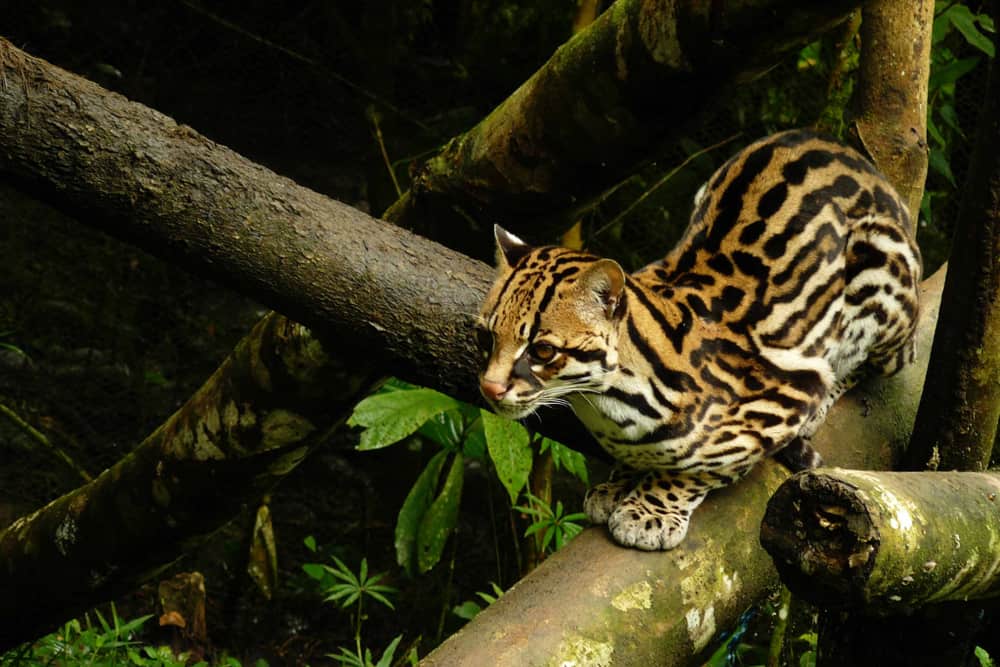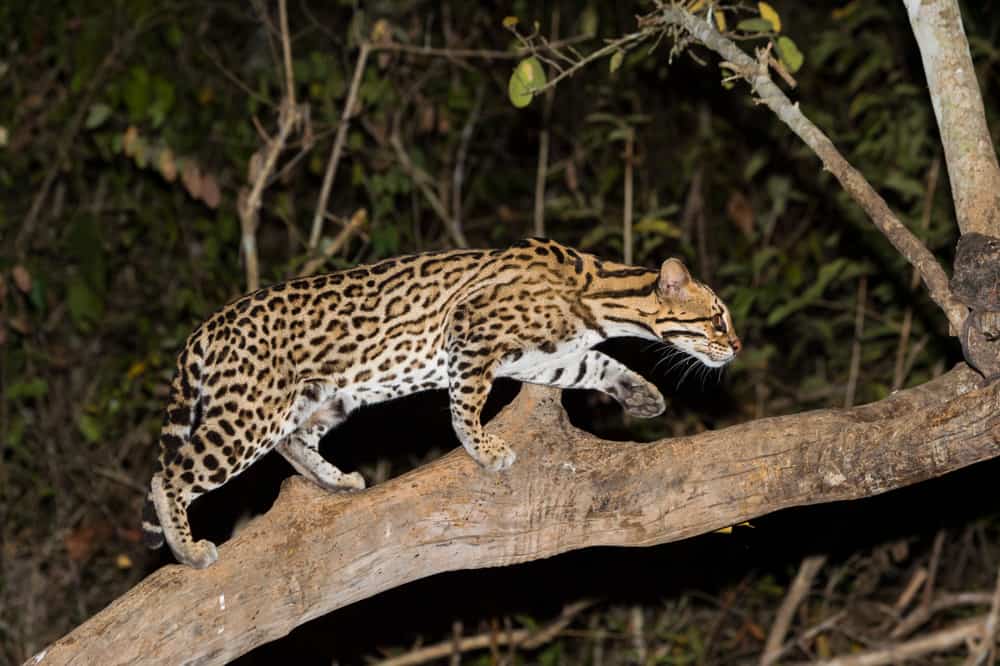Ocelots are beautiful wild cats that people often describe as little leopards. They are smaller than bobcats and a little larger than domestic cats.
But what do ocelots eat? Do they hunt for the same foods as other wild cats? We will hop into that in a second but right now, let’s learn a thing or two about what ocelots are and their general behavior.
Ocelot Habits and Biology
Ocelots are sleek animals with gorgeous coats marked in distinctive colors and patterns. Each ocelot has a unique pattern and the majority have dark sports covering their tan, white, or orange coat. Because of the stunning marks, ocelots are also sometimes referred to as painted leopards, and because of their small sized-bodies, some people also call them dwarf rabbits.
But these critters are not close relatives of true leopards. Leopards are members of the Pantherinae subfamily (roaring cats) and ocelots belong to the Felinae subfamily (small cats).
While larger than domestic cats, ocelots have similar features as housecats – limber bodies, narrow jawlines, and long tails. Mature ocelots usually range between 30 and 40 inches in length and weigh around 14 to 33 pounds. Females are smaller and lighter, with the majority weighing somewhere between 15 and 25 pounds.
The animals inhabit various environments including coastal marshes, scrubs, savanna grasslands, tropical and subtropical forests, and mangrove forests. They are mostly found in the US, Central America, Mexico, and South America.
They prefer to stay alone and will only come together to mate. During the breeding season, males and females will mate 5 to 10 times a day. The reason for this is that it’s often very difficult for female ocelots to get pregnant.
The gestation period is about 79 to 85 days, and a single female will reproduce between 1 and 3 young ones, commonly referred to as kittens. Baby ocelots are very tiny at birth, and will only weigh about 6 to 10 ounces. They will live with their mothers in the same territory but once they are 2 years old, they will set off to live on their own.
The males are usually ready to mate by 15 months old. Females, on the other hand, take a little longer to become sexually mature, with the majority taking around 18 months, although some take up to 22 months. Ocelots will have a lifespan of about 10 to 13 years.
What Do Ocelots Eat in the Wild?
Ocelots are carnivores, meaning, they only eat meat. Their teeth are specially designed to tear through the toughest of flesh. They have sharp incisors to remove meat from the bone as well as a strong set of back teeth to slice it into manageable smaller pieces.
These little cats will actively hunt at night and rest during the day. They will climb trees to hunt or catch prey on the ground. Every night, they will travel over 4 miles to hunt.
Ocelots are picky eaters, though. They will often remove the feathers and fur from their prey before they can start to eat it. To avoid wasting food, ocelots will hide their leftover prey and come back to eat it when they get hungry again.
Watch this video of an ocelot catching and killing an iguana:
What Do Ocelots Like to Eat?
Ocelots will often feast on small prey such as:
However, sometimes they will also go for larger animals like monkeys and young deer.
How Ocelots’ Diet Benefits the Ecosystem
By feeding on rats and mice, ocelots help minimize the damage associated with these rodents. Rats and mice not only cause diseases; they also gnaw on your electrical cables, storage items, and grain. They ruin the structural integrity of homes too.
In addition, they leave feces and urine everywhere they roam, providing a rich breeding ground for bacteria. Rats have also been found to damage farm crops, which can significantly reduce food supplies.
While traps may help bring down the population of these rodents, ocelots do a pretty good job too. They catch and eat these bothersome critters, lessening the harm they may cause both to humans and the ecosystem.
Facts About Ocelots
1. Ocelots Have Excellent Vision and Hearing
Ocelots, like all small cats, can see and hear pretty well. Their eyes are designed with an extra layer that reflects light, which helps them to see in the dark. In fact, these cats can walk around and perform their activities at night just as good as humans would during the day.
They have quite a strong sense of smell too, and this coupled with their long whiskers helps the animals not only feel their way around but also know where there is food.
2. Ocelots Are Nocturnal
Ocelots are mostly active at night and are very secretive. On cloudy or rainy days, you may also see a few roaming around during the day.
When they are not moving about in search of food, they will be resting in places where there is dense vegetation like thick chaparral or tropical rainforests. They will hide among bushes, inside hollow trees, or on thick tree branches to sleep.
Without enough places for ocelots to hide, predators will easily find them and these little creatures won’t survive. In fact, whenever trees, bushes, and shrubs are cut down in ocelots’ habitats, these cats just leave.
3. Male Ocelots Don’t Care for the Young Ones
After mating, males and females go separate ways. Once the female gives birth, she takes the responsibility of caring for her babies and she will protect and feed them all by herself.
Female ocelots will often give birth in hollow trees, secluded thickets, caves, or rocky bluffs where their little ones can stay safe. They will, however, move the kittens to different den sites when they feel threatened.
4. Ocelots Communicate in Different Languages
Ocelots talk to each other using different vocalizations, body language, and scent marking. Whenever they sense danger, they will stand with stiff legs, arched back, with their tail held straight down.
They will also make different noises to mark different experiences or different times of their life. For instance, when they are excited, they will chuckle and when looking for a mate, they will yowl.
5. Males Fight Males from Other Territories
Male ocelots will keep territories that overlap 3 or 4 female territories so they can find their mates easily. Usually, a male ocelot will claw logs, leave droppings strategically on trails, and spray vegetation with his urine to mark his territory.
Other males will identify these marks and stay away, and if they cross into a territory that is not theirs, the male in the invaded home will not be so friendly.
6. People Hunted Ocelots for Fur
Because ocelots are beautiful, they were often hunted and killed for their fur before the 70s. The fur was then used to make coats, and it could take up to 30 ocelots to produce just one coat. Luckily, in 1972, bringing ocelots’ skin into the United States and other countries became illegal.
Since then, not many people buy ocelot skins anymore and these cats are not hunted in large numbers like before. However, ocelots are still losing their lives when people cut down trees and shrubs in areas where they reside.
7. Every Ocelot Markings Are Unique
The markings and patterns on each ocelot’s coat are unique. These spots, which are also known as rosettes, are black or dark brown and the fur underneath usually has a light yellowy brown or golden tan.
Immediately after birth, ocelots appear to have the same spots, but as they grow, these marks start to look more defined and unique.
8. Ancient Peruvians Worshipped Ocelots
Some artwork in different parts of Peru hints that people worshipped ocelots back in the day. The Moche people, especially, who were famous craftsmen and artisans engraved pictures of this special cat in their murals and metalwork.
9. Ocelots Walk Slowly While They Hunt
Ocelots can run really fast when escaping from predators, but while searching for their own food, they prefer to take their time, walking only at a speed of around 0.2 mph.
Sometimes they will just lay and wait for prey to appear and can sit at one spot for over an hour. If they can’t find something to eat, they will walk slowly to a different area where they will again sit and wait.
Ocelots prefer looking for food in places where there is some vegetation cover, and will rarely hunt in open areas, as these can make them get spotted quickly by their prey.
Here is a video that explains ocelot facts in detail:
Summary
Ocelots are avid hunters who survive mainly by eating meat. They will prey on small terrestrial critters like birds, reptiles, and rodents but will sometimes take on larger prey like monkeys and deer young ones. These cats are nocturnal and will prefer to hunt during dawn or dusk when they can’t easily be spotted by their prey.

